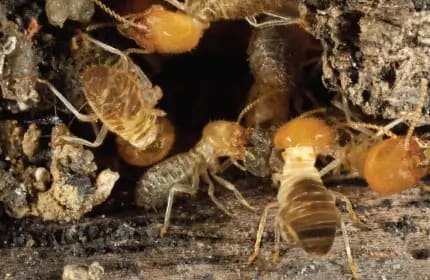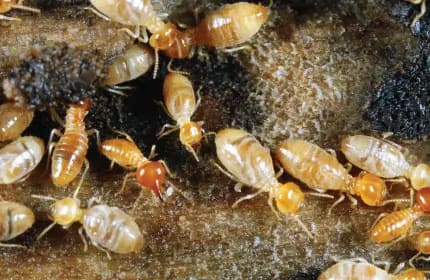


TERMITES
Over 100,000 Australian residential properties suffer from termite attacks each year, causing millions in damage to timber and other materials in homes.
Although termites are small, they can be deadly to your home and its internal structures, particularly in the warm climate of Queensland which is ideal for termites to wreak havoc and risk significant devalue to your home. They have good survival instincts and have survived for millions of years.
Understanding the different species and life-stages of a termite is important, so you are able to effectively identify, eradicate and prevent an infestation.
Along with an annual termite inspection, you can prevent an infestation by addressing any external leaks around your home, getting rid of any old or unused wood and avoiding having garden mulch, watering systems or wood directly against your house - this can all make for a very inviting nest for a termite! Annual Pest Management recommends regular inspections in order to detect the early onset of termite infestation.
TYPES OF TERMITES
Subterranean Termites
The most common termite: Subterranean Termites are small, soft bodied insects that live underground. These termites require a source of moisture to survive, so they build large nests and build underground tunnels from mud that can reach up to 100 metres away from their nest. They use this technique to gain access into structures for food and water. This species of termites is notorious for the damage they can cause to your property.
Subterranean Termites create damage from the ground up, they feed on timber and enter buildings from the sub-structure. You can identify Subterranean Termite damage in timber as it will show hollow tunnels (known as ‘galleries’) along the grain of the timber. These termites range from 3mm to 9mm in length, have cream coloured bodies and brown heads.
Drywood Termites
Drywood Termites live above ground in pieces of timber. Unlike the Subterranean Termites, they do not require water to survive, however they do require a humid environment. These termites live in colonies of up to 1000, with several colonies usually living inside one piece of timber. Drywood Termites can cause severe structural damage to your home, or other wooden items within your property. If left undetected, these pests will feed on an entire piece of wood, leaving just a thin layer of the surface.
They commonly infest areas of the home including decks, wooden stairs, roof sheathing, floors, window frames and even furniture. Depending on the maturity and role of the Drywood Termite within the colony, their appearance may vary; the ‘workers’ are cream coloured whilst the ‘soldiers’ and ‘swarmers’ are brown or black.
Dampwood Termites
As the name suggests, Dampwood Termites live in wood with high moisture levels and are commonly found in humid, cool climates - typically in coastal areas. These termites are typically larger than Subterranean or Drywood Termites, with a large head and winged bodies. You may find Dampwood Termites in old timber decks, roof eaves or wooden substructures that have been damaged by water leaks or exposed to a lot of rain.




